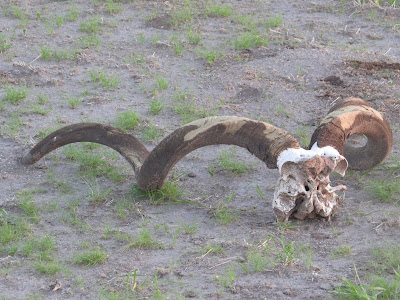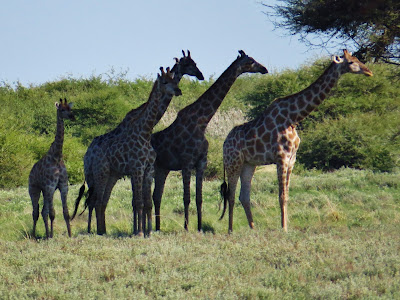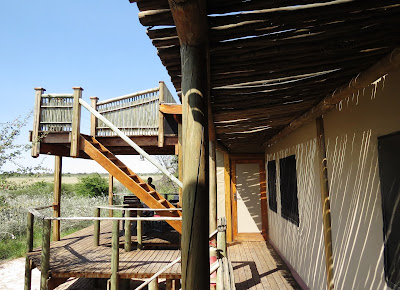These photos were all taken in the Kalahari Desert, where we stayed at Kalahari Plains in the Central Kalahari Game Reserve. This camp is one in the Wilderness chain of safari camps (click
HERE for the Wilderness website). We met fellow guests who were staying at a string of Wilderness camps. The company has its own fleet of small aircraft to pick up guests at airports and to shuttle them between camps. It's also known for stressing local culture. At Kalahari Plains, we were met by a number of the women employees singing a cappella in either Swahili or a local tribal language. There was also "dancing Bushmen" at one dinner, and the bush walk (see photo below).
For more photos from our early 2016 Africa trip, keep scrolling and hitting "older posts" when you get to the bottom (before the canal boat photo). Click
HERE for a written account of the trip, along with links to Kalahari Plains and all the other safari lodges and camps we visited.
 |
| Northern black korhaan. |
 |
| Black-backed jackal. |
 |
| Black-headed heron. |
 |
| Some watering holes look a lot like mud puddles. . |
 |
This was our introduction to kudus, We later saw these antelope
alive and well elsewhere in Botswana. |
 |
| An oryx, also known as a gemsbok. |
 |
| Adbim's stork. |
 |
Southern giraffes; in Tanzania we saw
Maasai giraffes. We were told there are seven
different types of giraffe. The southern
giraffes' color is a bit more muted than
that of the Maasai. We saw only those two types. |
 |
| Hartebeest. |
 |
Our canvas-walled cabin at Kalahari Plains. We slept every night
under the stars on the raised deck. The staff put mattresses on the
floor for us and made up very comfortable beds. No dew, so
everything was dry when we woke up. |
 |
One night at Kalahari Plains, dinner was served outdoors. The bonfire
is a ritual at most safari camps. Everyone sits around and chats before dinner. |
 |
This San Bushman, an employee at Kalahari Plains safari camp, traded his
usual clothes for traditional Bushman attire (no idea if anyone still wears loincloths
in real life) to take us on a walk in the bush. Here he's demonstrating
how to make a simple snare for trapping small game. |
 |
| Black mamba snakes aren't always black. |
 |
| Our guide guessed that this black mamba was more than two meters long. |